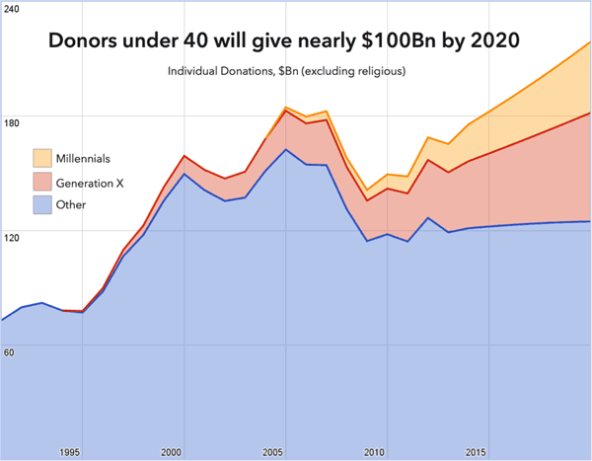Millennials are unlike any generation to date. They think about impact, act on the move, and communicate as digital natives. By 2020, an estimated $100 billion dollars annually will flow from young donors into the nonprofit sector. Nonprofits who speak to them in their native language, communicate with technology, and offer them a wide range of ways to engage will benefit from this massive giving potential.

Young, tech-savvy donors matter:
- Gen X and Gen Y donors currently comprise 30 percent of total donated dollars.
- They are willing to be advocates; they share where they give with their friends, spread the word, and (with the help of a little smart technology on the nonprofit’s side) will mobilize new donors to causes they love. From 2012 to 2014, social fundraising grew by 32 percent, and 50 percent of Gen Y donors say they’ve posted about a nonprofit on social media.
- They hold the future of philanthropy. Looking beyond 2020, these donors will inherit more than $30 trillion over the next 30 years; the organizations they fall in love with now are ones they’ll likely support for years to come.
These donors are changing the philanthropic sector.
Nonprofits have long relied on traditional customer relationship management systems to communicate with traditional donors in traditional ways, and for good reason: These systems work reasonably well for email blasts, event invitations, and direct mail. Traditional donors expect these communications, and act on them. But the same methodologies are lost on the Millennial generation. As digital natives, they expect to interact solely through technology, and eschew other forms of communication and transaction—only 10 percent of Gen Y donors mailed a donation check in the last two years. Nonprofits that don’t change their traditional methods risk being ignored, or judged as not innovative, old, stale, and irrelevant.
Are you enjoying this article? Read more like this, plus SSIR's full archive of content, when you subscribe.
Consider successful companies like Uber, Airbnb, and Seamless. They quickly spread as both easy and fun solutions to problems Millennials didn’t yet realize they had. Can’t find a cab? Restaurant doesn’t deliver? There’s an app for that. Once used, forever adopted, and virally spread like wildfire. Philanthropic donations will be the same.
Five ways to engage millennials:
- Get out of their in-boxes, and get into their pockets. Direct mail and enewsletters have open rates below 30 percent. Young donors are looking to engage online in creative ways, rather than via emails and mail—62 percent of Gen Y donors say they would give via mobile. For example, One Acre Fund, which supports smallholder farmers, keeps an up-to-date impact dashboard to share metrics with donors, and posts updates such as actual and projected numbers of families served via web and mobile friendly software.
-
Let them get to know you, not just your beneficiaries. Millennials love thinking about the organization they support as well as the cause. Successful crowdfunding campaigns illustrate the power of sharing authentic stories. The Marina Abramovic Institute, for example, raised support from nearly 5,000 supporters via Kickstarter to build a new performance and education space, by sharing the founder’s personal journey and mission.
-
Share the facts. Younger donors are more than twice as likely as older generations to demand data about impact. Organizations such as Evidence Action use rigorous evaluations and randomized control trials to identify poverty-reducing interventions. Sharing what works (and what doesn’t) has allowed it to build deeper relationships with donors, and grow its individual donor base by more than six-fold between 2013 and 2014.
-
Invest in a great online checkout. Make sure your online donation experience is easy—younger donors are hesitant to mail a check, but love easy online options. Text-based giving raised $41 million after the Haiti earthquake, and nearly 50 percent of Gen Y report donating online.
-
Be transparent. Younger donors want honesty— fast-growing organizations like the Akshara Foundation transparently report and blog about their research, successes, and failures. They post reports on teacher interviews, classroom observations, and school surveys. Share the good and the bad, and donors will trust you and help you grow.
Support SSIR’s coverage of cross-sector solutions to global challenges.
Help us further the reach of innovative ideas. Donate today.
Read more stories by Angela Rastegar Campbell.

